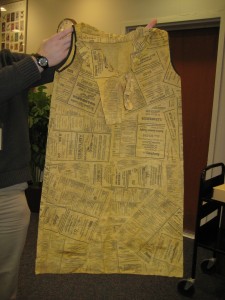Carey MacDonald is an undergraduate Anthropology major and writing intern. In her blog series Through the Lens of an Anthropologist, Carey analyzes artifacts found in the collections of Archives and Special Collections.
What began in January 1878 as George Coy’s and Morris Tyler’s New Haven District Telephone Company serving a mere 21 customers in New Haven, Connecticut, ultimately became the Southern New England Telephone Company (SNET) serving millions of customers by 1970. SNET was a leading force in the evolution of modern communication systems. Interestingly though, it was also a leading force in creating a profound sense of pride and loyalty among its employees. What is most intriguing is how SNET achieved this.
The ‘Yellow Pages Dress,’ found within the SNET Company Records, was a promotional item for the company’s Ecology Program that began gaining ground in 1968. A second dress made of yellow pages is found in another grouping of SNET-related items known as the SNET Collection. According to Laura Smith, Curator for Business, Railroad, and Labor Collections, when the second dress was donated in 2010 by Mr. Joseph Kennedy, a former SNET employee from 1948 to 1978, it was not cited as an Ecology Program promotional item like the first dress was. However, despite this terminological difference, it is apparent that both dresses stem from the same period of the company’s history.
Both dresses are literally made of yellow pages paper – advertisements and all – which was recycled from old telephone directories, treated, and sewn together into a shift dress shape. The dresses were made by the Waste Basket Boutique by Mars of Asheville, North Carolina, and some of the other dresses made by the Boutique are also found in the archives of the University of North Carolina Asheville.
Intriguingly, Laura Smith says that it is most likely that these dresses were not actually meant to be worn, but were instead given to employees as pieces of company memorabilia – as representations of the SNET institution as a whole.
Smith says that although both dresses show some slight tearing, they do not appear to have been worn habitually, or even just occasionally, by anyone, further suggesting that their purpose was simply to evoke employees’ loyalty to and pride in the SNET Company. At a time when unionizing was very common, it was especially important for SNET to keep its employees content. By organizing such events as sports games and by distributing such things as these yellow pages dresses, for example, SNET could maintain the structure of its business and avoid potential dissent among its employees.
Additionally, the dresses, particularly the one explicitly named as a promotional item for the Ecology Program, helped to foster company cohesion by forming a unifying environmental awareness among employees. This awareness, in turn, helped SNET develop ecological policies aimed at making a greener Connecticut, as seen in the SNET Company Records collection.
For instance, in the early 1970s, SNET Company President Alfred Van Sinderen enlisted former Connecticut Governor John N. Dempsey to act as an environmental consultant on the potential ecological issues of SNET operations. Upon spending months in the field observing SNET Company operations, Dempsey wrote his 1977 report, “Impact.” In it he declares that SNET employees would no doubt accept and support the Ecology Program as some employees freely articulated their sincere concern for the environment. Dempsey also discusses the need for people in the higher-ranking managerial positions of the company to effect the actual implementation and maintenance of such a program. Such things as the company dispersal of the 1977 Employee Education handbook, which contains tips for employees on how to be “green” and environmentally sound, worked to create an ecological consciousness within the company.
Ultimately, it appears that SNET developed the yellow pages dresses as part of a 1960s-1970s campaign to gain employees’ dedication to the company as a whole. It also appears that since one of these dresses was made particularly for the Ecology Program, it was part of the same campaign to unite employees under a company-wide environmental consciousness. Undoubtedly, the socially unifying and ecologically perceptive policies of Southern New England Telephone are utterly fascinating. This artifact study looks at the SNET Company as a microcosm of the larger social world in that it demonstrates just how people initiate and contribute to a socially bonding experience or movement. We can only hope, though, that those who initiate such a unifying movement do it for noble reasons and do it well.
Carey MacDonald, writing intern

